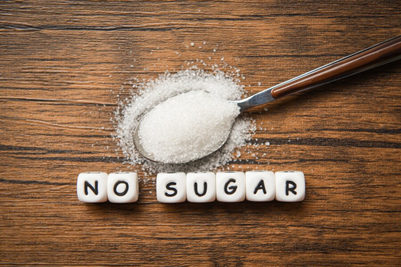Understanding Type 2 Diabetes: Causes, Symptoms, and Treatment Options

How to Live a Sugar-Free Lifestyle with Diabetes
01 Mar 2024
You can love it, hate it and escape it too! Yes, we’re talking about sugar. Living a sugar-free diet is possible without compromising taste—how cool is that? Let’s dig into how you can live a sugar-free diet as a person with Type 2 Diabetes.
But what exactly is sugar?
Sugars are a form of carbohydrate in foods, acting as a source of energy for your body. They are essential to your diet and aid many biological processes. Sugar is present in natural foods such as fruits, veggies and dairy products and also in manufactured products. It is the manufactured ones that you need to save yourself from. They’re often labelled under different names such as glucose, sucrose, maltose, molasses, honey, etc. That’s why developing a habit of reading food labels is great for your health.
What’s the need to go sugar-free, you ask?
Well, there’s all the need for you to live sugar-free because it has lots of benefits, especially for people with diabetes. Here are some to give you an idea:
- Controls blood sugar levels
- Improves insulin sensitivity
- Promotes heart health
- Aids in weight management and obesity reduction
- Manages cholesterol levels
- Enhances dental health
How to go sugar-free?
Good question. We say–start small. Don’t directly aim for the end goal. Rather, aim for the journey. Here are some tips for you to get started:
1. Start small and succeed big
While a sugar-free diet plan sounds great, training your palate for sugar-free tastes is even better. For something you’ve had almost all your life, it can be difficult to eliminate it. That’s why we say, start small and gradually remove sugar from your diet. The first few weeks can be low sugar instead of no sugar. This is the time when you can train your palate to get used to a less sugary lifestyle so it’s easy to get to a sugar-free lifestyle.
You can still eat foods with natural sugars such as fruits until you go completely sugar-free.
- Replace soda and fruit juices with water.
- Dry fruits have added sugars so be mindful of the quantity.
- Always go for whole wheat bread, pasta and grains with no added sugar.
- Add fewer sweeteners to your tea/coffee and breakfast like cereal.
You may feel cranky at first, for not being able to consume your favourites. But it’s only momentary and your body will get used to it soon. Then, a healthy lifestyle will not seem so far.
2. Ditch the sweet sugars, obviously
Before learning about hidden sugars in foods, start by cutting out the obvious sugary items. Yes, it means saying goodbye to your sweet tooth. No more ice creams or baked items, no more cakes and muffins either. As delicious as they are, they only help your taste buds and not your health.
Although some foods with naturally high sugars (dry fruits, flavoured yoghurt, milk) have good nutrient content and help with a healthy lifestyle, you can try to cut those down as well and train your palate even better.
3. Food labels exist for a reason, learn how to read them

Going sugar-free is a journey where you will learn every day. You will learn about foods that have high sugars, hidden sugars etc. The more you know, the better it is for your health.
Hidden sugars are present in most packaged products. Eg: bread, rice, pasta, crackers etc.
You can avoid these hidden sugars by reading the back of these products and spotting ingredients that may contain hidden sugars.
These hidden sugars show up with different names on packaging, which is a manufacturing trick. But worry not, we’ll help you decode all the names so you can read labels like a pro and become sugar-free successfully. Here you go:
- Glucose
- Maltose
- Fructose
- Sucrose
- Lactose
- Dextrose
Ask yourself – does it end with ‘ose’?
Then out it goes!
It can sound overwhelming at first, but once you learn what foods have sugars, following a sugar-free diet will start coming naturally to you.
4. Artificial sweeteners are a big NO
Be wary of artificial sweeteners; they can sometimes be more harmful than sugar itself. They trick you into believing that you get to consume sugar without actually having it. But these sugar substitutes are not healthy. They can destroy any sugar-free lifestyle progress that you may have made because they can trigger your cravings. Ultimately, sticking to your sugar-free diet plan becomes harder.
Although these sweeteners are marketed as sugar substitutes for cooking, they’re often added to packaged products as well.
Back to labels, look out for these words: neotame, saccharin, sucralose, aspartame, and acesulfame potassium. These are the sweeteners you need to avoid.

5. Don’t forget to cut sugary drinks
Don’t just focus on solids, liquids can be sugar-heavy too. Avoid drinks like hot chocolate, flavoured milk, fruit juices, soda, tonic water etc. Cocktails and alcohol can carry sugar too.
6. Unsweetened is the way to go
Accustomed as we are to sugar, switching to unsweetened versions of our favourite foods might seem unappealing at first. But they appeal to your body. These products have no added sugars and the only sweet taste you might feel will be of the default product. Whenever a label has the word “unsweetened”, consider it your muse. Don’t forget to check for natural sugars though. Depending on whether or not natural sugars are a part of your diet, you can decide to consume them.
7. No sugar does not mean no flavour
Choosing a sugar-free diet doesn’t mean sacrificing flavour. Although it may seem like that in the beginning, some variety in flavours might do the trick. You can try adding spices, seasonings and other ingredients that can add flavour. You can try vanilla too. There are plenty of options. If you put your mind to it, discovering sugar-free ways to enjoy your food may turn out fun. You can explore unique ways to enjoy your favourite foods without consuming sugar, plus savouring more flavours. A double win!
8. Collect nutrients from other sources
Removing naturally sugary foods from your diet requires replacing them with alternatives that offer similar nutrients.
For instance, fruits high in vitamins and fibre can be replaced by vegetables with the same nutrients. Be sure to eat a diversity of veggies so your body gets all sorts of nutrients.
You can also consider adding daily supplements to your diet. Take time, talk to your doctor and plan your food consumption accordingly.
Switching to a sugar-free lifestyle can seem like a hard nut to crack. But remember that the efforts you put into going sugar-free, even if you just limit your intake, create a good impact. You can also keep trying strategies like alternate no-sugar and low-sugar diets week to week until you’re certain that your palate has been retrained.
Rest assured, the results will soon become evident with better skin, increased energy, weight loss, and more. A sugar-free diet is bad news only for your tongue. You will realise that your body has no complaints.

Medically reviewed by
Dr. Devina Aswal 
MBBS, DDM, FCR, CIC
Recent Blog
- AI in Healthcare: Not a Threat, but a Smart Ally
- Your Clinic. Your Website. Your Brand.
- CDSS – Revolutionising Diagnosis with AI-Powered Clinical Decision Support System
- Handwritten to Digital in Seconds: SmartSync Converts Prescriptions Instantly
- Voice Rx by TatvaPractice: A Smarter Way to Digitise Prescriptions
Archives
Categories
- Asthma (20)
- Diabetes (15)
- Fatty Liver (20)
- High Blood Pressure (2)
- High cholesterol (2)
- Hypertension (2)
- Insulin Resistance (1)
- Obesity (8)
- PCOS (6)
- TatvaPractice (13)
Let’s Connect
Quick contact



